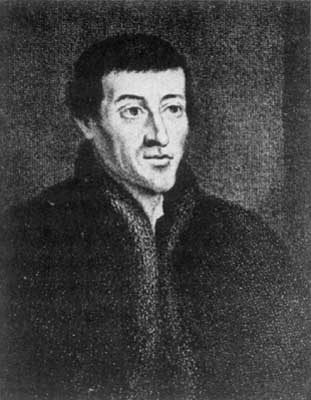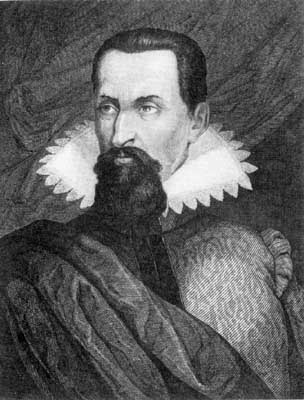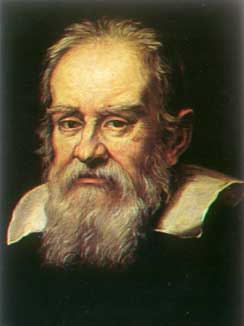The Story of Newtonian Mechanics
"If I have seen further, it is by
standing on the shoulders of Giants."
-Newton
| The ancient Greeks believed in Aristotelian Mechanics. In particular,
they believed in a geocentric (earth-centred) universe and that the
planets move in circular orbits. To explain observed planetary motion,
astronomers created epicycles. If this still does not fully explain the
observations, epicycles on epicycles were added to make it work.
Ptolemy (200 AD) collected these ideas and published the book,
Almagest, which remained the principal astronomy text until
Copernicus' revolutionary theory. The geocentric model is also called the
Ptolemaic model.
Nicolaus Copernicus (1473-1543), a Polish astronomer, after
studying Ptolemy's work realized that some of the difficulties of the
Ptolemaic model can be overcome by heliocentric (sun-centred) model. To
prevent prosecution from the church he delayed the publication of his work
On the Revolutions of the Celestial Spheres until just before his
death. But because it is a highly controversial work in those times, few
people accepted it. |
 |
 |
Major improvements on the astronomical tables did
not come until the Danish astronomer, Tycho Brahe (1546-1601),
built his great observatory near Copenhagen. He collected data which
improved the accuracy of the tables by 5 times. However, his observations
were all via the naked eye, because it is not until 1610 when the first
telescope was invented. Major breakthrough in astronomy had to wait for
Johannes Kepler (1571-1619), who fitted Tycho's wealth of data to
obtain his 3 laws of planetary motion. His first two laws was published in
Astronomia nove (The New Astronomy) and his third law in
Harmonices mundi (Harmony of the World). His work helped astronomy
became 100 times more accurate than before. The 3 laws are:
Kepler's First Law (K1L): The orbits of all planets are ellipses
with the sun as one focus.
Kepler's Second Law (K2L): A line
from the sun to the planet sweeps out equal areas in equal times.
Kepler's Third Law (K3L): The period of revolution, T,
is proportional to the mean distance of the planet from the sun, r.
|
| Galileo Galilei (1564-1642) made major
contributions to Newtonian Mechanics. Among his works is Il
Saggiatore, which contained the Law of Pendulum, Law of Falling Bodies
and his experiments with balls and inclined planes. His experiments made
him the inventor of modern experimental science. He also discovered that
an object in horizontal motion will keep moving horizontally at constant
speed forever (Law of Constant Motion). His greatest work is Dialogue
Concerning Two New Sciences (1638). In it, he combined the Law of
Constant Motion and the Law of Falling Bodies to prove that projectiles
move in a parabola. In addition, he improved on the first telescopes and
pointed it to the sky, making many great observations. With all these
works, Galileo has paved the way to Newton's 3 laws and the Law of
Gravitation. Before that, Ren� Descartes (1596-1650) generalized
Galileo's Law of Constant Motion to Newton's First Law of Motion. |
 |
Isaac
Newton (1642-1727) produced his famous work Principia in 1687. In
it, he formulated what is now known as Newtonian or classical Mechanics. His 3
Laws of Motion are familiar to everybody:
| Newton's First Law (N1L): |
Every body stays in its state of rest or constant motion in a straight
line, unless acted upon |
|
by external forces. |
| Newton's Second Law (N2L): |
Force exerted is proportional to the rate of change of momentum and
the line of action is in |
|
the direction of the change of velocity. |
| Newton's Third Law (N3L): |
Every action produces an equal and opposite reaction. |
|
|
And his Law of Gravitation is stated as
| Newton's Gravitational Law (NGL): |
Gravitational Force between two bodies is proportional to the product
of masses of |
|
the bodies and inversely proportional to the square of the distance
between them. |

In his line of reasoning, he assumed the truth of N1L, N2L, N3L and K3L. Then
he proceeded to deduce K2L from N1L and N2L. He proved that centripetal force =
mv2/r using N2L and the definition of velocity. With the centripetal
force and K3L, he proved NGL. He did not stop here. He carried on to deduce K1L
from NGL and his 3 Laws of Motion. He also showed that NGL and his 3 laws always
produce a circular velocity diagram.
Subsequently, NGL was confirmed time and again, and became an indispensable
tool for Celestial Mechanics. Newtonian Mechanics reigned for more than 2
centuries until the rise of Einsteinian Mechanics. The latter although far
superior than Newton's Theory did not totally replace it, because of the
simplicity and ease of use of Newton's Theory compared to Einstein's.
Return to Maths Homepage



